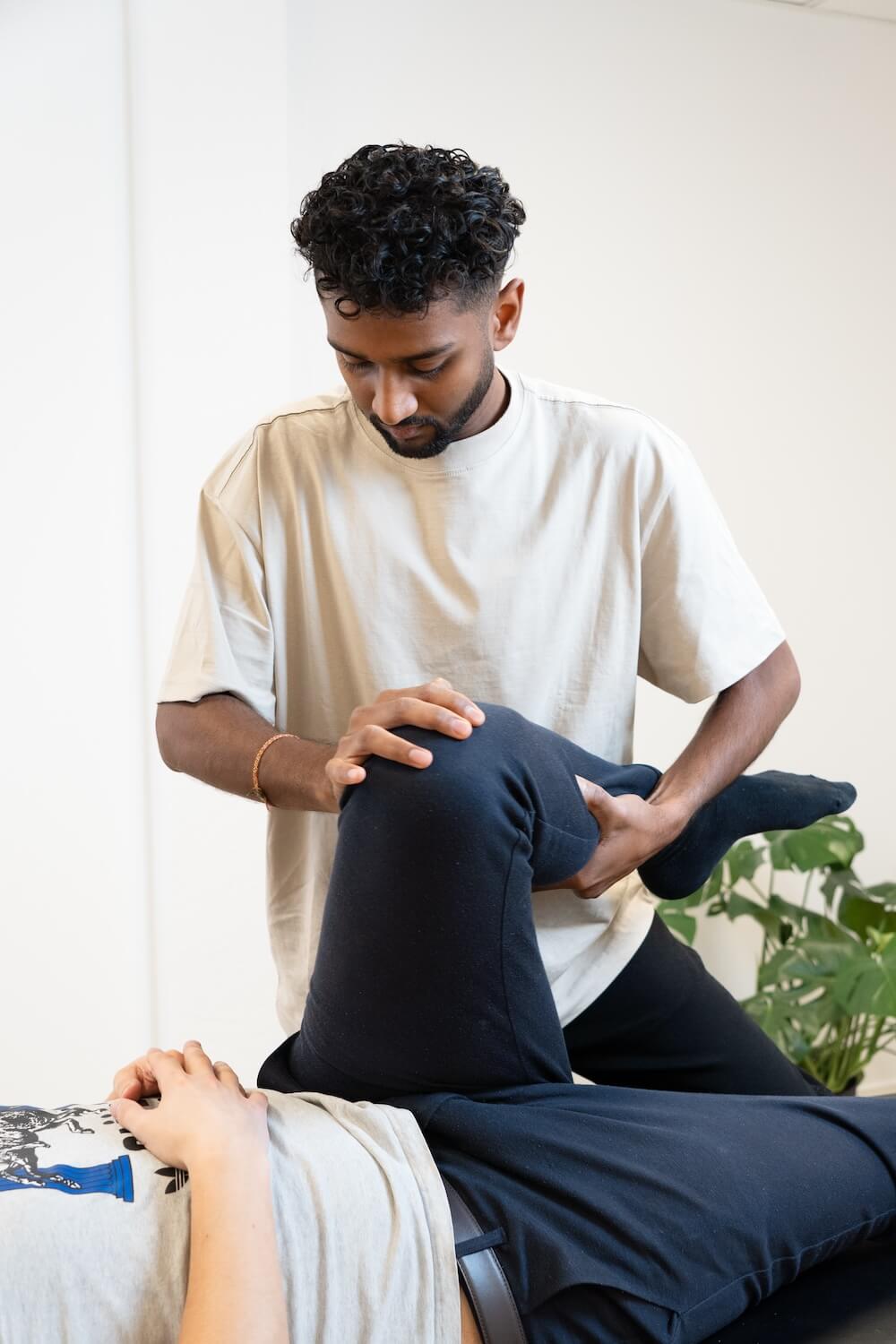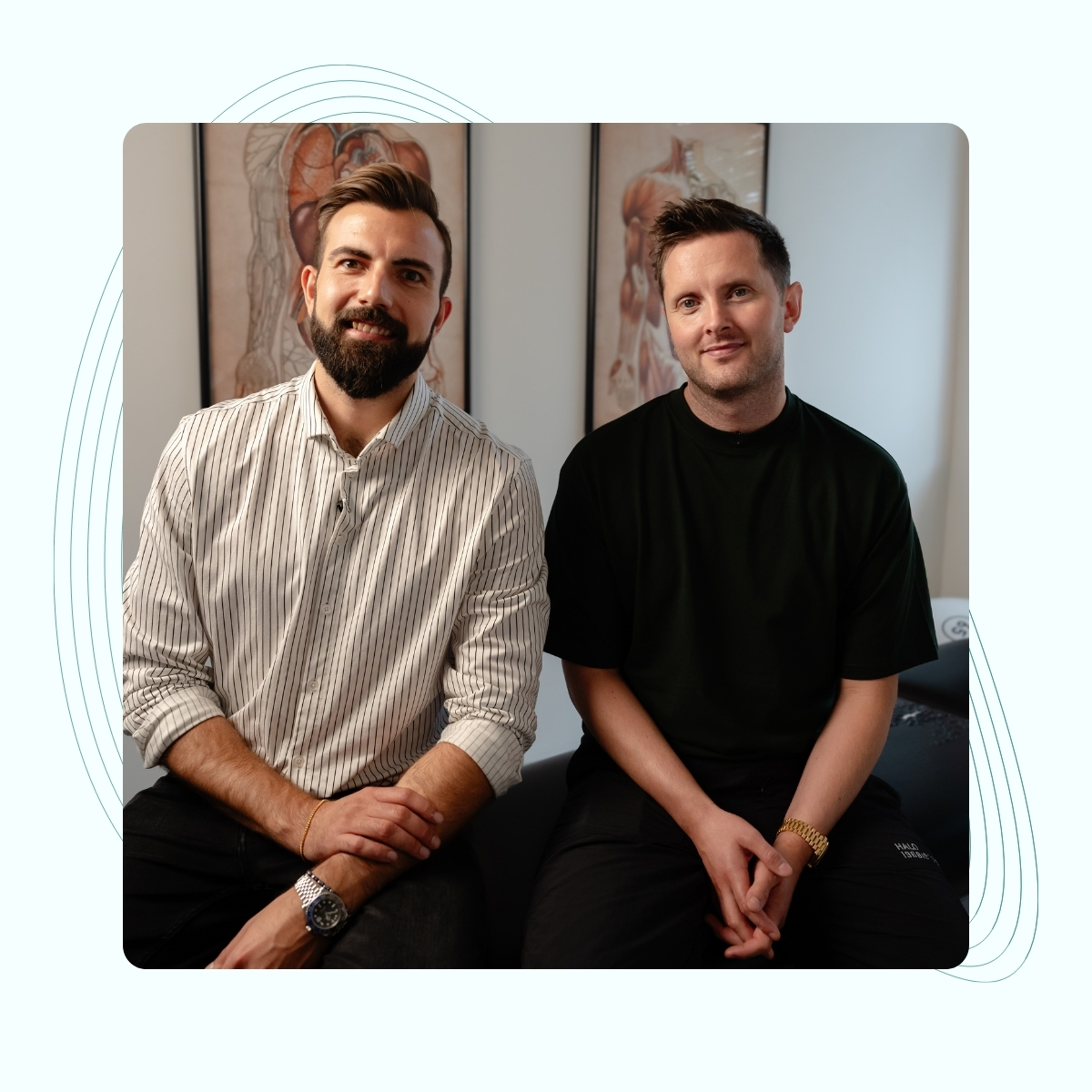We treat
Osgood Schlatter knee problems
Learn more about Osgood Schlatter and what problems it can cause for the knees and the body.
What is Osgood Schlatter knee?
Osgood Schlatter disease, also known as “Schlatter knee”, is the term for an overload of the bone point on the lower leg where the large extensor muscle group of the thigh attaches. The condition is also known as traction apophysitis, which means that an inflammatory condition occurs at the tendon attachment to the bone because the pulling forces from the muscle group exceed the capacity of the attachment.
Jump to section [Show]
Understanding the leg muscles
The large extensor muscle group of the thigh is called the m. Quadriceps, and as the name suggests, the group consists of four muscles. These are responsible for extending the knee and are used especially in sports that involve jumping, running, sprinting and kicking. One of the muscles, the m. Rectus femoris, originates from the pelvis, which is why it has a dual function and is therefore also involved in flexing the hip. The other three muscles are called; m. Vastus lateralis, m. Vastus intermedius and m. Vastus medialis.
The muscles run down the front of the thigh and meet in a tendon, which attaches to and runs down over the kneecap before finally attaching to the shin bone, the tibia. The point of bone where the tendon attaches is called the tibial tuberosity, and this is where you will experience cardinal symptoms such as tenderness, pain, swelling, warmth and redness.
These symptoms are classic signs of inflammation and occur because the bone point becomes overloaded and inflamed.

What symptoms are experienced with Osgood Schlatter?
The symptoms of Osgood Schlatter are tenderness and pain locally at the tendon attachment on the tibial tuberosity. Depending on the degree of overload, redness, warmth and swelling may also be experienced.
As mentioned, these symptoms are signs that an inflammatory process is taking place – meaning that the body has initiated a repair of the damage.
The pain is triggered by physical activity and will typically be worst during and immediately after physical exertion.
The pain will typically be relieved when the knee is relieved and kept at rest. If the problem has been present for a long period of time, you may experience pain simply when the knee is bent – for example, when kneeling, when tying shoes, or when sitting in the back seat of the car, where legroom is limited.
The pain can also be triggered if you bump your knee, and direct pressure on the tendon attachment hurts and feels uncomfortable.
Why does Osgood Schlatter occur?
Osgood Schlatter is typically seen in children and adolescents aged 10-15 years who are physically active and growing. Up to 20% of children and adolescents who are active in sports are affected by Osgood Schlatter, while the condition is more atypical in those who are not active in sports, where approximately 5% are affected.
A key word is growing age, as a growth spurt can often be a decisive factor in the development of a Schlatter knee. The femur bone grows longer, which increases the requirement for how much the patellar tendon must be able to stretch. At the same time, the bone point Tuberositas tibia is not completely fused with the rest of the shinbone, which is why it can actually move quite a bit. The large pull in the tendon attachment from m. Quadriceps can cause small tears in the tendon fibers, which results in inflammation of the tendon and the bone point. This inflammation can also result in small calcifications in the area.

Osgood Schlatter in adults
Most cases of Osgood Schlatter improve with age and will disappear with weight-bearing or as puberty ends. Here we see a complete fusion of the bone area on the Tibia, which becomes stronger and less vulnerable to tendon pull from the muscles.
In some cases, however, you may continue to be plagued by Osgood Schlatter, even after puberty has ended and you have become an adult.
This typically happens because small pieces of bone have formed in the area, which can break loose and result in swelling at and below the tendon attachment.
If you suffer from Osgood Schlatter as an adult, you often had some degree of it as a child or young adult, but this does not have to be the case. The condition can also be triggered by a fall or twist, where small pieces of bone become detached and cause swelling and irritation in the area.
How do you know if you have Osgood Schlatter?
Osgood Schlatter is characterized by local tenderness/pain and swelling at the tibial tuberosity. The pain occurs and worsens with physical strain on the patellar tendon, but will initially improve with relief and periodic abstinence from the activity(ies) that trigger the symptoms.
It is not recommended to avoid sports completely, but the level of activity should be dictated by the intensity of pain.
One should therefore stay active to the extent that the pain does not worsen. Some may benefit from practicing a different type of sport or physical activity for a period of time.
Osgood Schlatter can typically be diagnosed based on the medical history, combined with swelling corresponding to the tendon attachment and active testing of the m. Quadriceps against resistance, which will trigger local and known pain. If there is doubt about the diagnosis or if the presence of another disease is suspected, an X-ray can be performed to confirm the hypothesis. However, this is rarely necessary. General examination of the knee and performance of other orthopedic tests can usually rule out other diseases.
Another classic sign of Schlatter is a bulge under the kneecap where the tendon attaches to the lower leg. The bulge can occur due to inflammation and will subside when you relieve and limit the triggering activity.
A more permanent bulge may also occur under the kneecap if there is bone growth in the area.
This bump itself will not require treatment or cause concern, but the bone thickening can be painful if you have a job that requires you to kneel a lot. In this case, it would be a good idea to use some form of knee protection to avoid direct pressure on the bone point.
Duration of Osgood Schlatter
The duration of Osgood Schlatter disease can vary and depends on several factors. Typically, the condition resolves on its own within 6-18 months, but it can also take years. For children and adolescents who are affected, the condition will usually disappear as puberty ends. The period of symptoms and their severity can be reduced if you receive treatment and guidance from your doctor, physiotherapist or osteopath.

Treatment of Osgood-Schlatter
Treatment can generally be divided into two phases and initially involves a period of relief to relieve the symptoms of pain and swelling. It will often be necessary to adjust the level of activity so that you can maintain an active lifestyle without exacerbating the problem.
Here, it may be relevant to consider whether you can practice another form of sport for a period of time or whether a reduction in the amount of training may be sufficient. Some experience such bad symptoms that a real break from sports may be necessary.
If a break from sports is not an option, you can try to relieve symptoms with bandaging or kinesiotape. The reasoning behind this treatment strategy is that with compression you can try to change the load on the area slightly, so that physical stress becomes more bearable. It is never recommended to maintain an activity level that worsens the pain, as this can lead to a longer and more complicated rehabilitation.
Pain management with over-the-counter painkillers such as paracetamol is recommended if you have severe pain. You can also consider Ibuprofen, which is an NSAID, which means it is anti-inflammatory and inhibits the hypersensitivity to this process. In this way, it has a reducing effect on the pain experience.
If you experience acute symptoms of Osgood Schlatter, the RICE principle can be used to relieve symptoms.
RICEM is an abbreviation for:
- Rest (rest and quiet)
- Ice (cooling the area to reduce swelling and pain. 3-4 times daily for 15-20 minutes)
- Compression (moderate compression and pressure that prevents and limits swelling)
- Elevation (positioning the leg above heart level to limit swelling, especially the first 2-3 days after acute onset of symptoms)
- Mobility (try to move as much as possible but within the pain threshold)
Once the symptoms have subsided and pain and swelling have been reduced, early rehabilitation and physiotherapy with mobility and strength exercises will be an important component for a milder and shorter course.
As previously described, the condition occurs due to strong pull from the muscles of the thigh, which causes the tendon attachment to tighten in an attempt to limit the range of motion.
This is done as a defense mechanism. Initially, it will be necessary to work on the mobility of the tendon so that it can gradually become more flexible. This is done through massage, mobilization and targeted stretching exercises, among other things.
Next, the muscles around the knee must be strengthened to increase capacity and control and to prevent the discomfort from returning.
Traditional adrenal cortex hormone blockade has not proven successful and effective in the treatment of Osgood Schlatter.
Osteopathic approach to Osgood Schlatter
The knee’s biomechanical position between the ankle and hip means that it is an important part of a chain that must ensure correct shock absorption from the ground when we move. The requirements for shock absorption become greater, especially when we run or jump. The foot and ankle are the first instance that meets the ground, which is why this is also where shock absorption starts. From here, the shock is propagated up through the lower leg and to the knee, before being carried further up to the hip and pelvis.
The latter is our foundation for the spine and the rest of the body.
If there is limited strength or mobility in one or more joints of the foot, the knee may have to compensate for this.
A mobility problem in the foot can easily have an influence on whether the knee is overloaded.
Reduced mobility
The same can apply if there is reduced mobility from the thoracic spine, lower back, pelvis or hip. Tight structures, including muscles, joints and ligaments, can compromise blood flow from our arteries and veins if these are pinched, so that there is not optimal vascularity in the area. Blood is the key to all healing, as it is with the blood that we transport fresh oxygen and nutrients to areas of the body that need it.
The fresh blood, filled with oxygen and nutrients, is pumped out into the body through the arteries. The used and oxygen-poor blood must return to the heart and lungs, which takes place through our veins. This happens through our pumping system, which is driven by our large breathing muscle, the diaphragm. The muscle is located in the chest and abdomen with close contact with the organ system. If there are movement restrictions in the thoracic spine or in the organ system, the pumping system may be affected, which is why optimal vascularity and healing of the knee is not ensured.
Locking of and reduced mobility in the back can have an impact on how the nerve activity is to a given area. Our m. Quadriceps is innervated by nerves from the lumbar vertebrae, L2-L4, which is why locking these segments can cause increased nerve activity to the muscles of the front thigh and thus increased tension.
The result of this will be that the tension in the tendon will increase, and therefore overload may occur over time.
The functions of the pelvis are many, but one of them is to house our pelvic organs. If stiffness occurs in the pelvis for one reason or another, the pelvic organs will have changed conditions to be able to move and perform their functions. This can result in increased afferent nerve stimuli to the spinal cord, which can have an impact on the efferent nerve signal to the muscles.
If you have problems with the digestive system, pelvic organs, etc., this can also be a contributing factor to whether there are altered neurological conditions around the knee.
The above examples are just some of the reasons that can cause problems in the knee joint.
The osteopathic approach to examination and treatment is to look at the body and all its systems as a whole, where a problem in one system can affect the function of other systems.
An osteopathic examination of knee pain therefore involves not only an examination of the knee, but also of the rest of the body to ensure that the underlying cause is identified and treated.

Good advice if you suffer from Osgood Schlatter
If you suffer from knee pain, it is always a good idea to have it examined so that you can be guided to the real cause and get a plan for the further course of action.
Treatment and supervised rehabilitation can limit the symptoms and the period during which you are prevented from performing or have to limit the activities you find important in your everyday life.
Other good advice:
-
- Adjusting activity levels so that you can maintain an active lifestyle without worsening your pain. This may involve reducing how often, how much, and how intensely you do the triggering sport/activity.
-
- Relieve the knee with calm and rest, so that the body has time and space to heal.
-
- Use the RICEM principle for acute pain, see description above.
-
- Common oral painkillers can provide symptom relief for severe pain.
-
- If a break from sports is not an option, you can try compression with bandaging or kinesiotape, so that the load on the tendon is changed in connection with physical activity. It is never recommended to maintain an activity level that worsens the pain, as this can lead to a longer and more complicated course.
-
- Once you have relieved the knee so that the pain and swelling have subsided, you should quickly start mobility training and stretching the tendon so that it becomes more flexible.
-
- Once increased flexibility is achieved, the structures around the knee must be strengthened to increase control and capacity and to prevent the discomfort from returning. Slow, heavy strength training is most effective for rehabilitating tendon disorders.
-
- Pain during exercise is acceptable as long as it does not exceed 4-5 on a scale of 0-10, and as long as it disappears afterwards.
-
- You can consider whether you are using the right footwear, or whether a different type of shoe, sole or insole can help with better shock absorption.
Good exercises for Osgood Schlatter
Standing stretch for the hamstrings
- Stand on one leg, possibly with support from a chair or wall to keep your balance.
- Bend your knee and grab the instep of the opposite leg.
- Try to bring your heel and butt together so that you feel a stretch on the front of your thigh and the front of your hip.
Tighten your abdominal muscles, push your hips forward and avoid bending your lower back too much, as this will remove the stretch in the front of your thigh. - Hold the stretch for about 30 seconds, repeat 3 times.
- Focus on calm and deep breathing, possibly increasing the stretch on a deep exhalation.
- The stretch can be performed several times a day.
- Alternatively, the stretch can be performed lying on your stomach based on the above principle.
Lying hamstring stretch
- Lie on your back with your legs stretched.
- Place an elastic band around and under your foot so you have something to pull on (alternatively a sheet or towel)
- Lift your leg using the elastic band, keeping it as straight as possible and your toes pointing up towards you.
- Feel the stretch in your hamstring and hold the position for about 30 seconds, repeat 3 times.
- Focus on calm and deep breathing, possibly increasing the stretch on a deep exhalation.
- The stretch can be performed several times a day.
Seated calf stretch
- Sit on the floor with your legs extended.
- Wrap an elastic band around your foot so you have something to pull on (alternatively, a sheet or towel can also be used)
- Pull the elastic so that the foot is brought back and the toes point up towards you. Keep one leg straight.
- Feel the stretch in the back of your calf and hold the stretch for 30 seconds, repeat 3 times.
- Focus on calm and deep breathing, possibly increasing the stretch on a deep exhalation.
- The stretch can be performed several times a day.
Prone mobility training of the lower back
- Lie on your stomach on the floor.
- Bring your arms under your shoulders and extend your elbows to lift yourself up.
- Take a deep breath and exhale through your mouth while trying to lower your hips towards the floor.
- Try to release the tension in your buttock muscles when you exhale.
- Repeat 10 times at a leisurely pace.
- If your lower back feels stiff and it’s difficult to get up on straight arms, you can start by working your way up onto your elbows.
- Lie on your elbows and find the calm you can. Focus on deep, calm breathing, holding the position for a few minutes if possible.
- Feel free to repeat several times daily.

Often related injuries
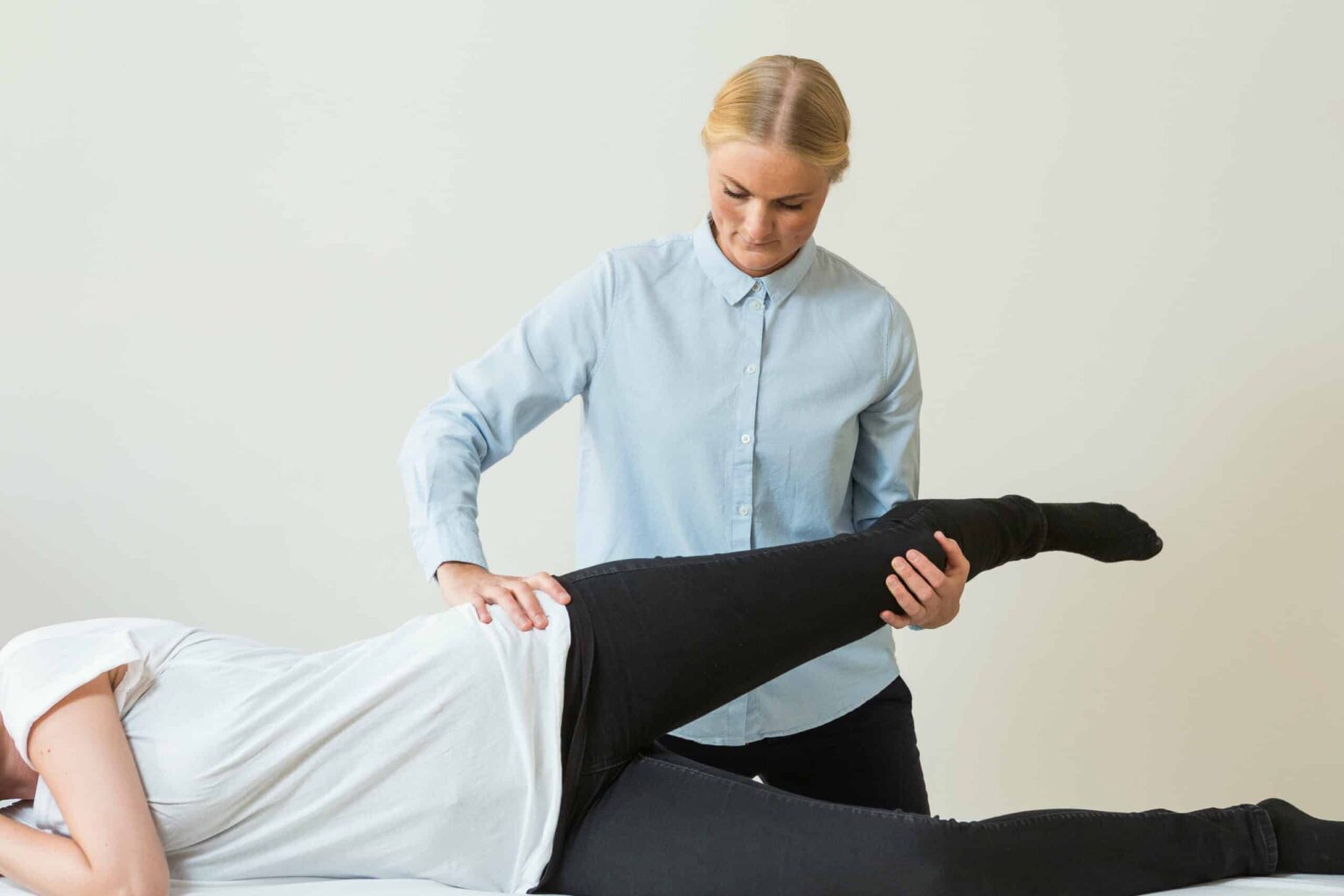
Restless Legs Syndrome (RLS)
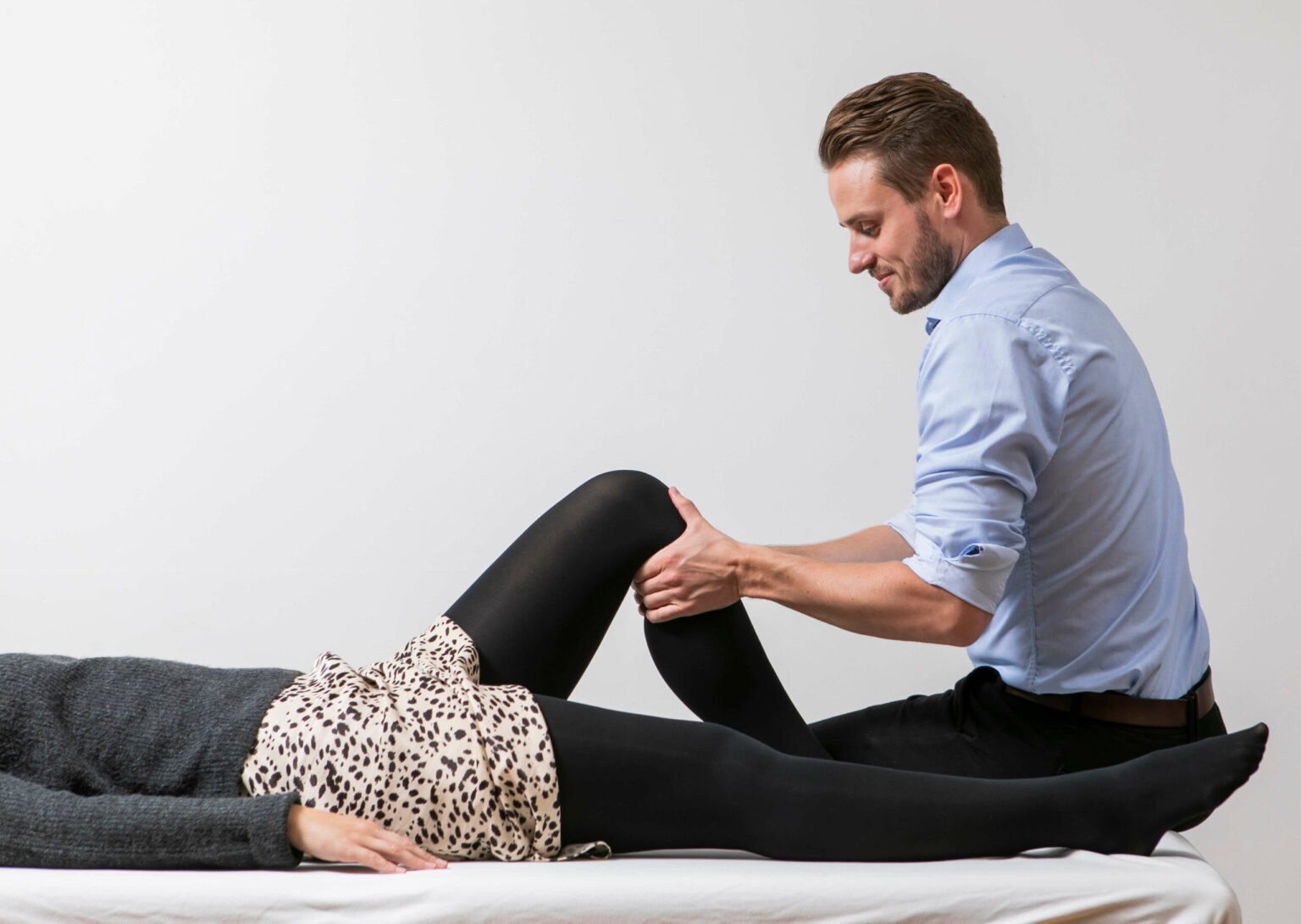
Cruciate ligament injuries – ACL/PCL
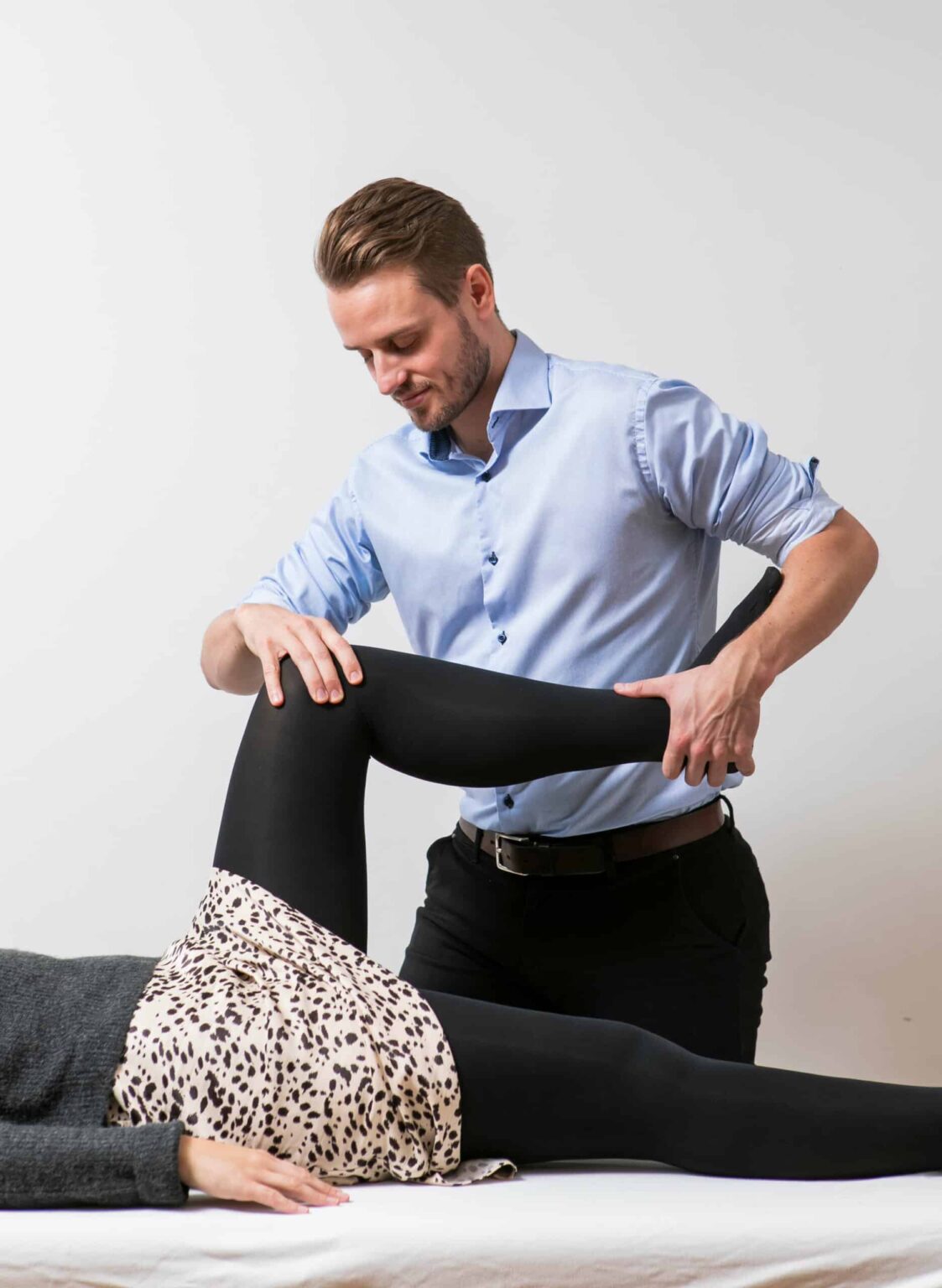
Synovial Plica
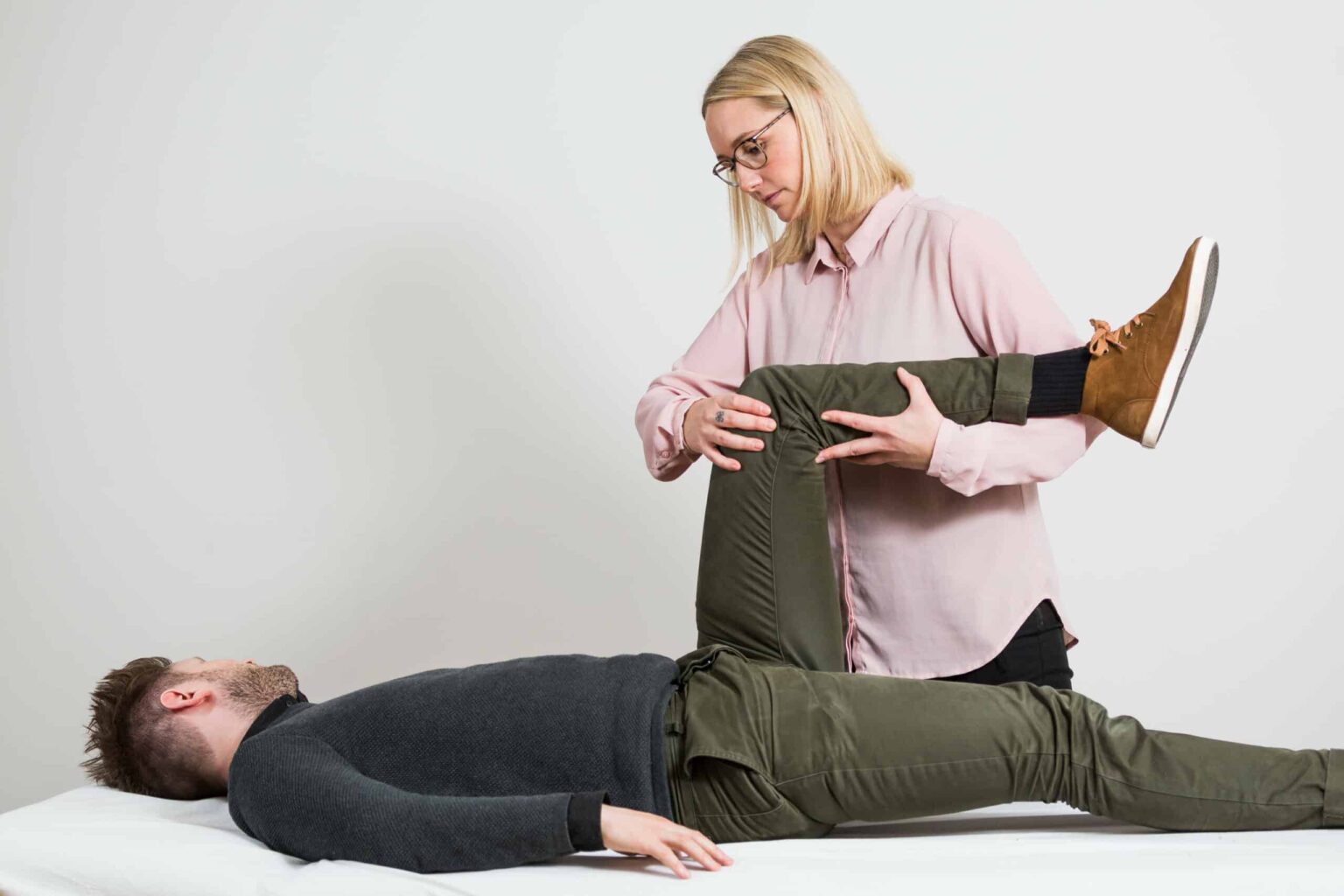
Pes anserinus tendinitis
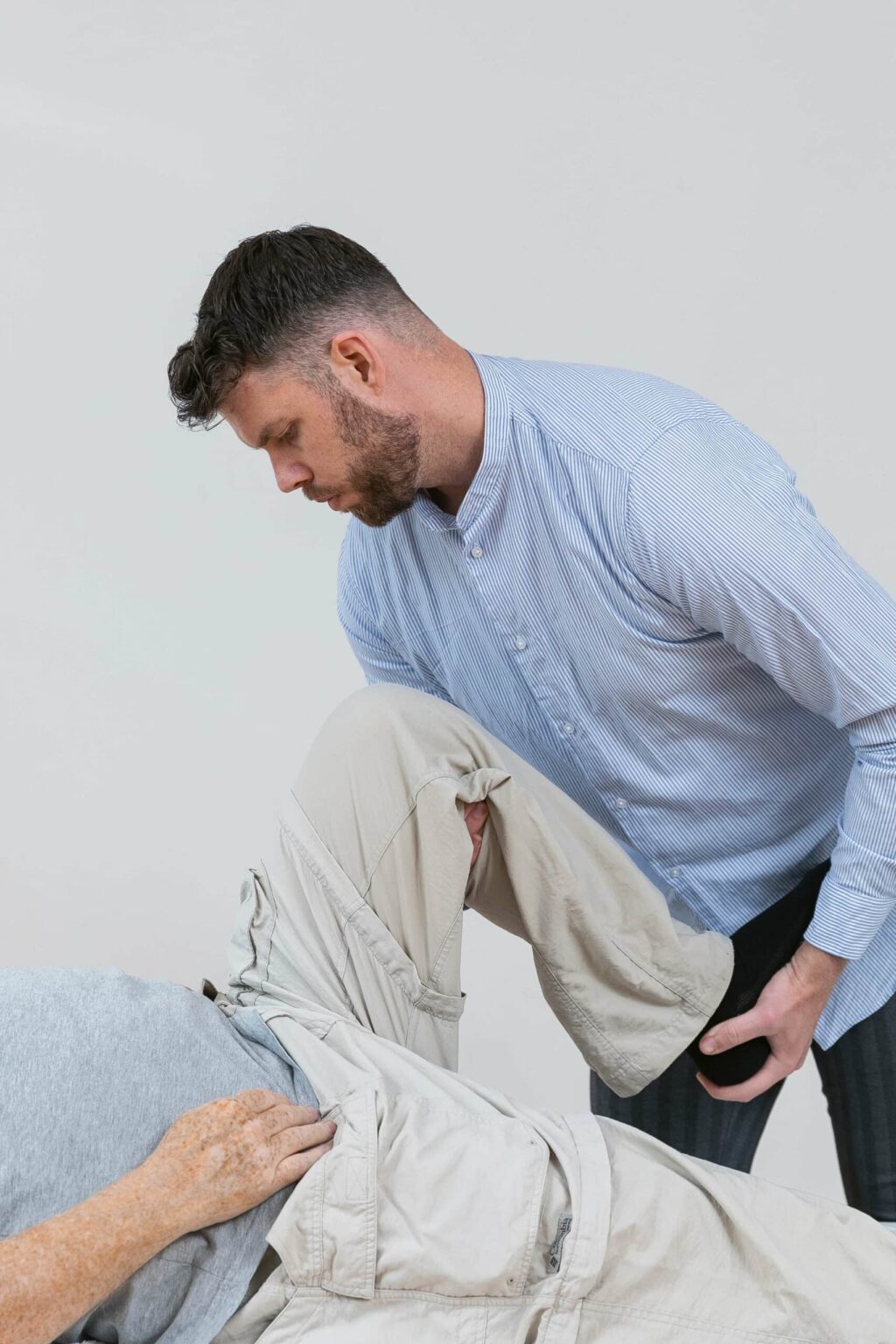
Jumper’s knee

Knee plica inflammation
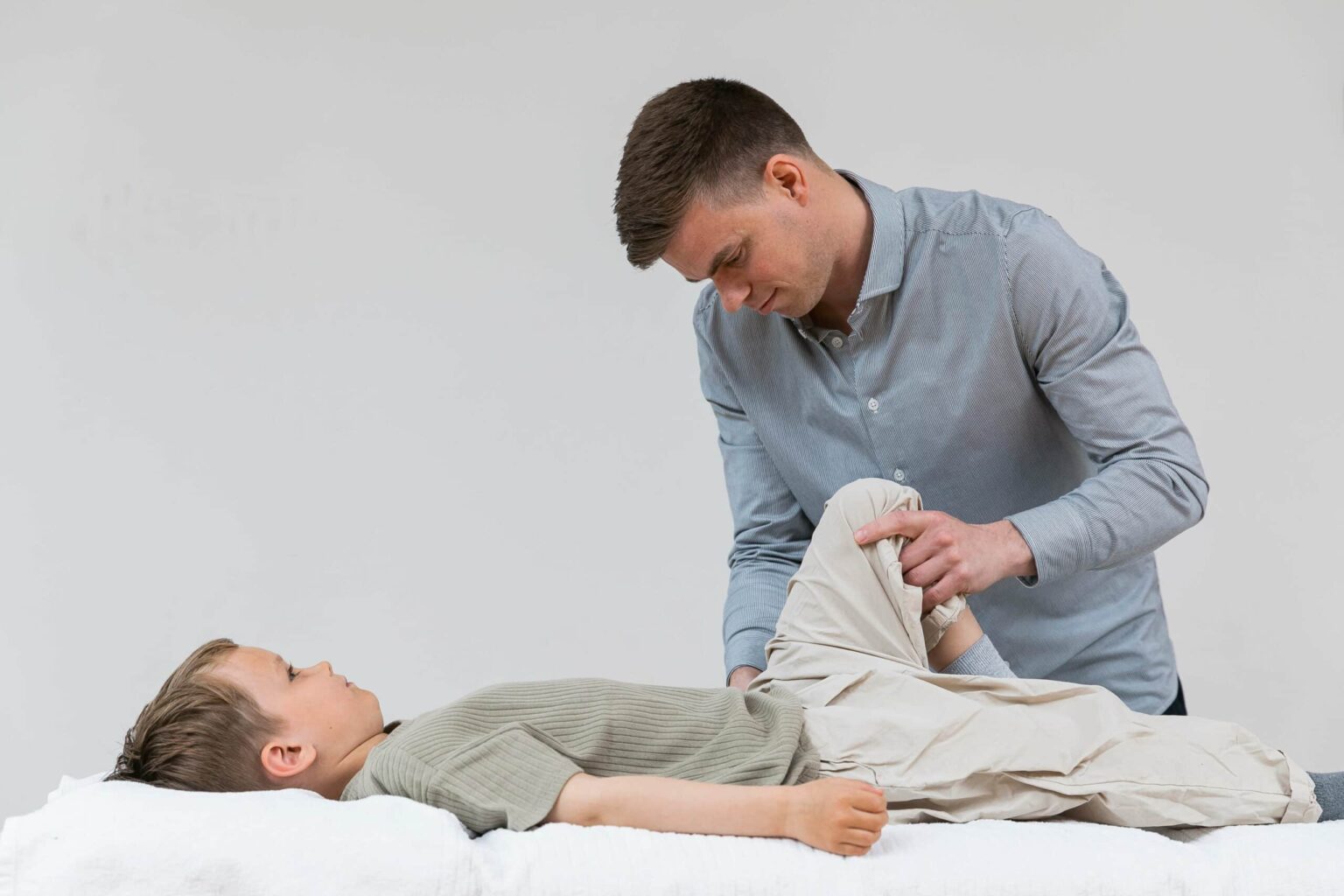
Osgood Schlatter
